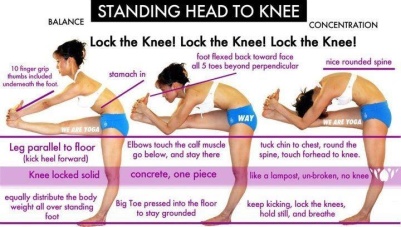STANDING HEAD TO KNEE POSE
By Jade Hall on Thursday, July 30th, 2015 in Uncategorized

Standing Head to Knee Pose (Dandayamana Janushirasana) is one of the most dynamic and challenging postures in the Bikram Yoga series, here is a detailed breakdown of this posture to help you better understand it…. and why we harp on so much about ‘lock the knee’.
ANATOMY
Contraction of :
Compression of:
- Pancreas
- Thyroid, Para-Thyroid (in 4th stage)
- Thymus (in 4th stage)
- abdominal organs
- reproductive organs
Extension of:
The proximity of the heart to the floor, puts pressure on the muscle, exercising the heart through elevating the heart rate.
Physical Benefits:
- Builds strength through the body
- Improves flexibility of sciatic nerve
- Strengthens tendons
- Prevents wear and tear of knee cartilage though strengthening of soft tissues around the knee
- Helps clear and prevent problems with digestion, including flatulence
- Helps to develop balance
- Helps maintain sugar levels through compression of the pancreas
- Improves blood circulation throughout the body
- Tones abdominal muscles and thighs
- Improves your sex life through the massage of your reproductive organs
- Helps to decrease varicose veins by exercising the long vein (great saphenous vein) running from the leg to the heart
Energetic Benefits
- challenge of the posture helps to build patience, determination allowing light-heartedness
- concentration required unifies the mind and body
- working on balance between right and left side helps to balance yin and yang, male and female energies in the body
- final expression of the pose involves both control and release, allowing you to let go of old patterns
- helps to improve confidence and self-worth
- helps to clam and clear the mind
Tips
Most sports will teach you to bend the knee to maintain the safety of the joint. Bikram Yoga is different. By balancing for one minute, the static nature of the pose makes it safe to lock the knee.
The “lock” is created by the contraction of the quadriceps muscles in the front side of the leg, this lifts the patella, creating space in the knee-joint, strengthening the soft tissues around the knee-joint to help protect the integrity of the joint.
This pose involves patience, one step of the pose must be complete before the next. Reference the picture of Huiping Mo above to get an idea of what each step should look like. Remember: it is not a race , you have plenty of time to master the posture.
Notice the positioning of the foot on the floor, your toes should not v-in or v-out.
Tips from the Pros
Always distribute your weight evenly on the foot (big toe, little toe, heel). When you keep your weight in your heel you are jarring your bones – Craig Villani
Those who have hyper-extended knees should always move the weight forward into the front of your foot and big toe. Most people with hyper-extended knees will hang out in the side of the foot and heel which causes you to use the quadriceps and back of the leg to sustain the pose. You must instead move the weight into the big toe to engage the inner thigh, helping you to use all the muscles in the upper leg to lock the knee. – Dana Moore, Co-Owner: Bikram Yoga Toronto
In the first part, make sure the thigh is parallel to the floor (when you kick, the leg). If the leg is above or below parallel it puts too much pressure on the lower back – Rajishree Chourdhury
“Do not grab the knee to modify the pose it is wrong” Bikram Choudhury
“Grabbing the knee to modify the pose jams the femur into the hip socket, damaging the joint.” Emmy Cleaves
For those who are overweight, have arthritis or other conditions and challenges, round the spine and grab wherever you can below the knee. – Rajishree Choudhury
Suck your stomach in. The abdominal region is a great source of energy. Compression of the abdominal organs will both protect your spine and give you energy for the pose. – Rajishree Choudhury
Always grab the ball of the foot, grabbing lower on the foot jams the femur into the hip socket when you kick – Craig Villani
When you kick, initiate the movement with the heel so that you extend the back of the leg properly. – Craig Villani
When you kick your leg out make sure to extend the heel forward and keep the hips in one line. If you displace the leg alignment, you effect the sciatic nerve, so keep the hips aligned. – Rajishree Choudhury
A huge thanks to Oh Mi Bikram for the above detailed breakdown of this pose. No point reinventing the wheel when they have done it for us so brilliantly.
